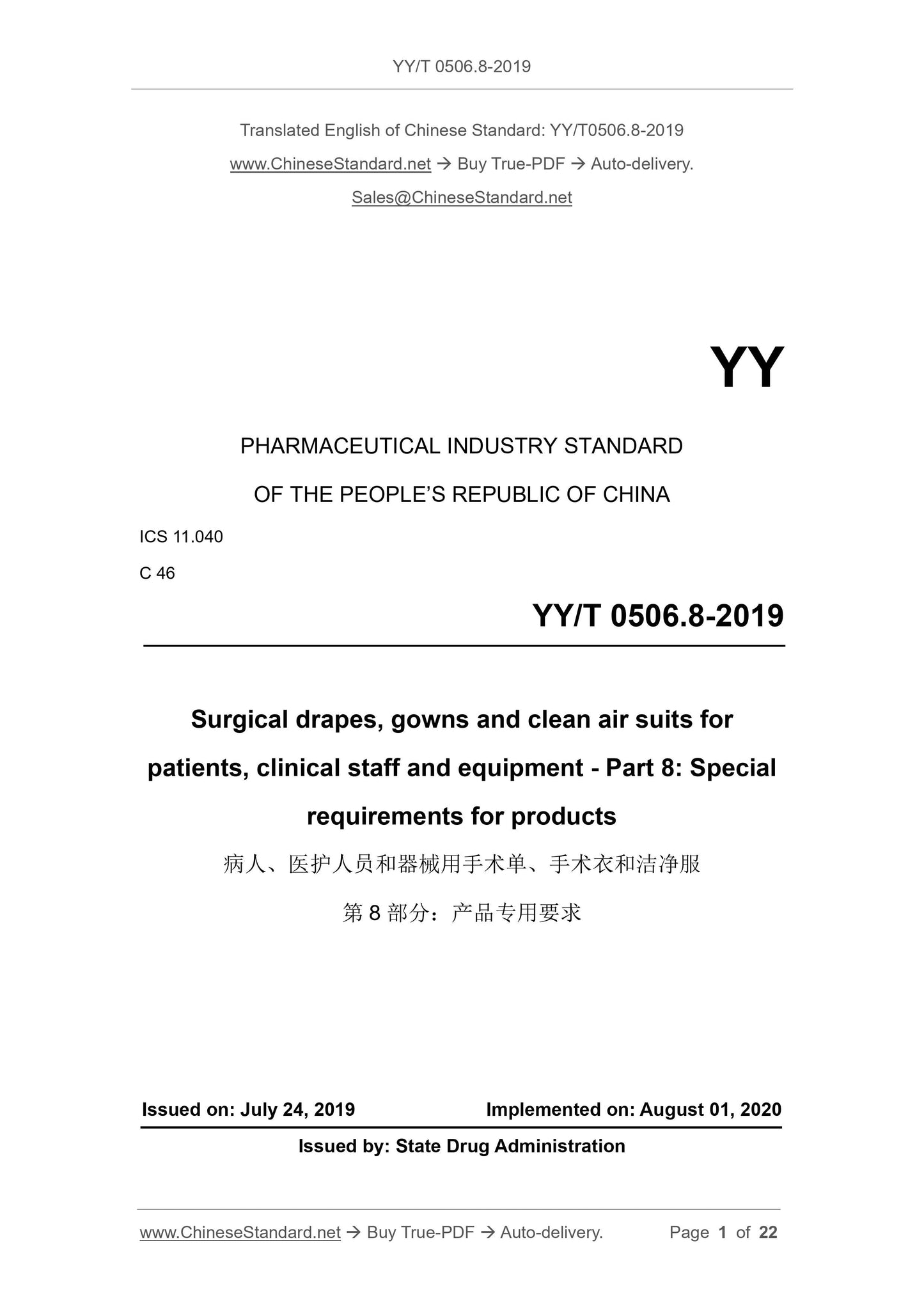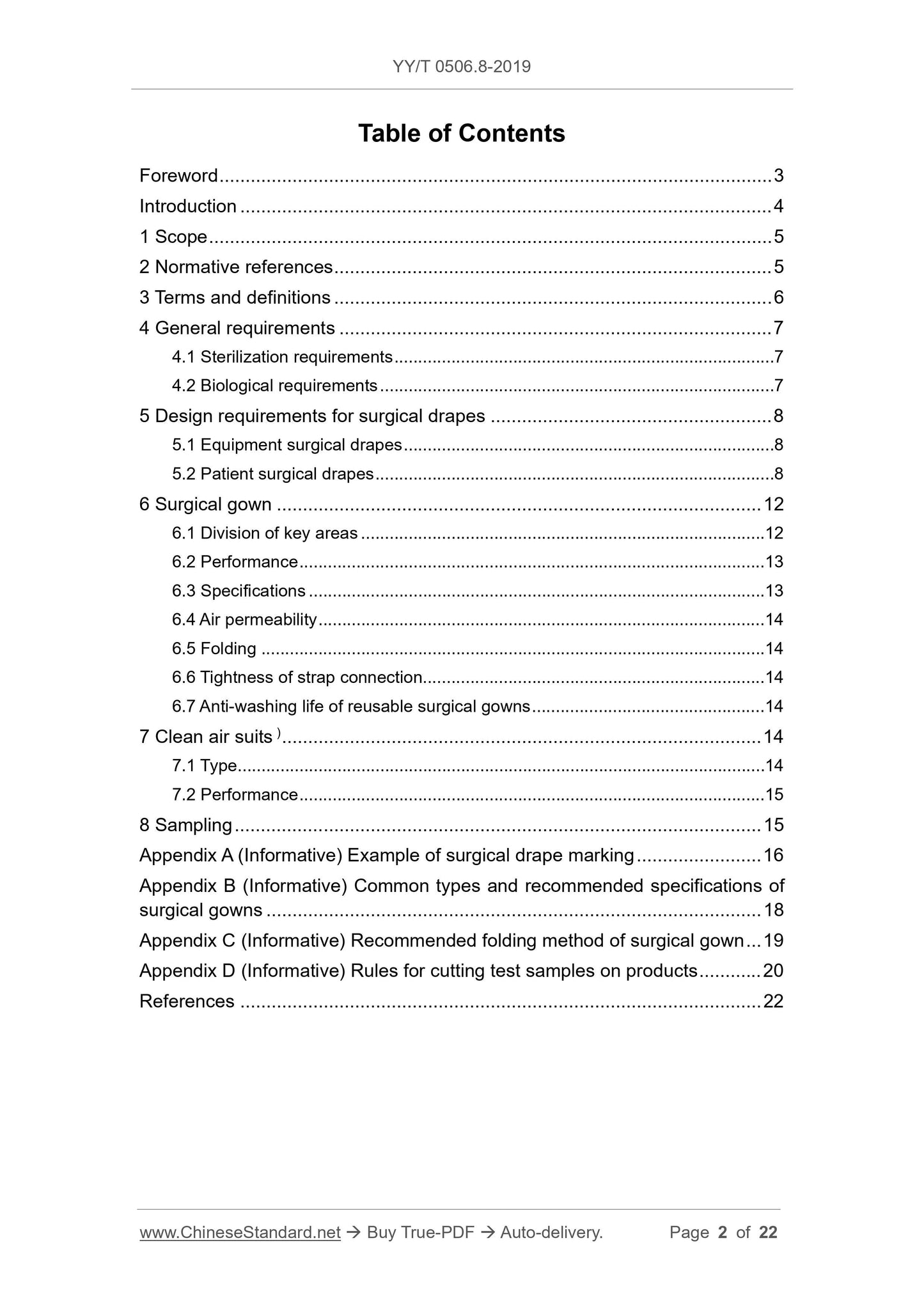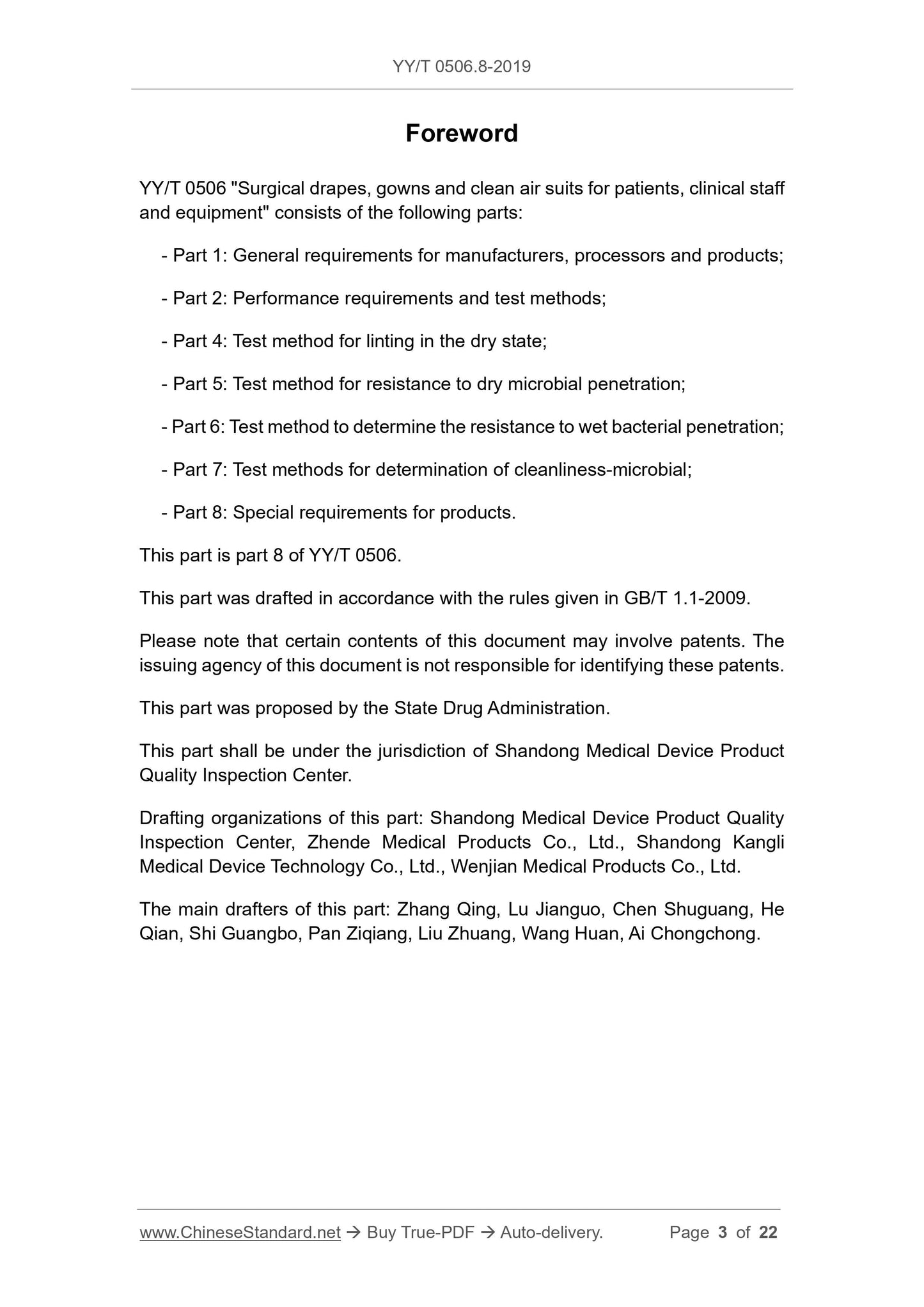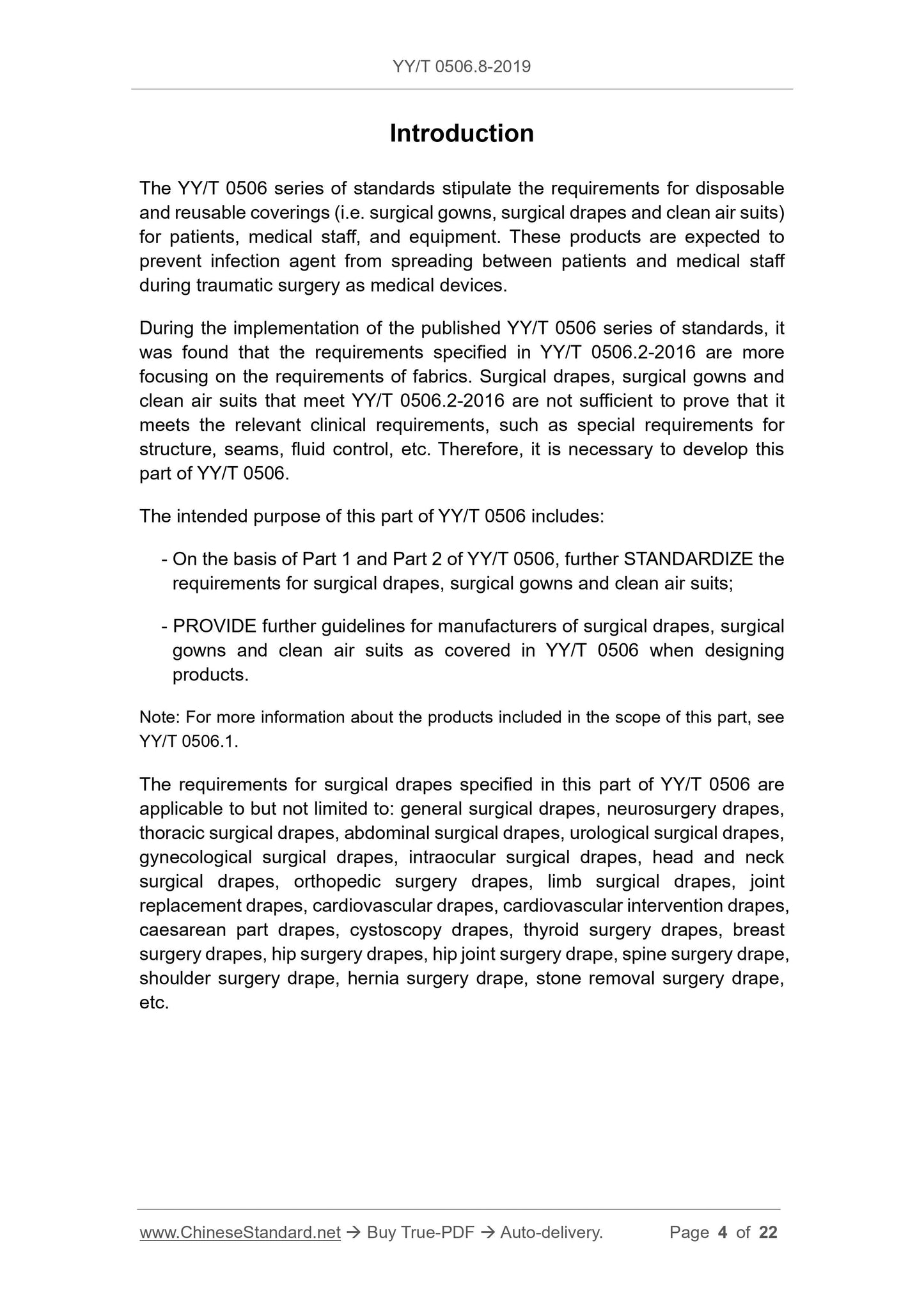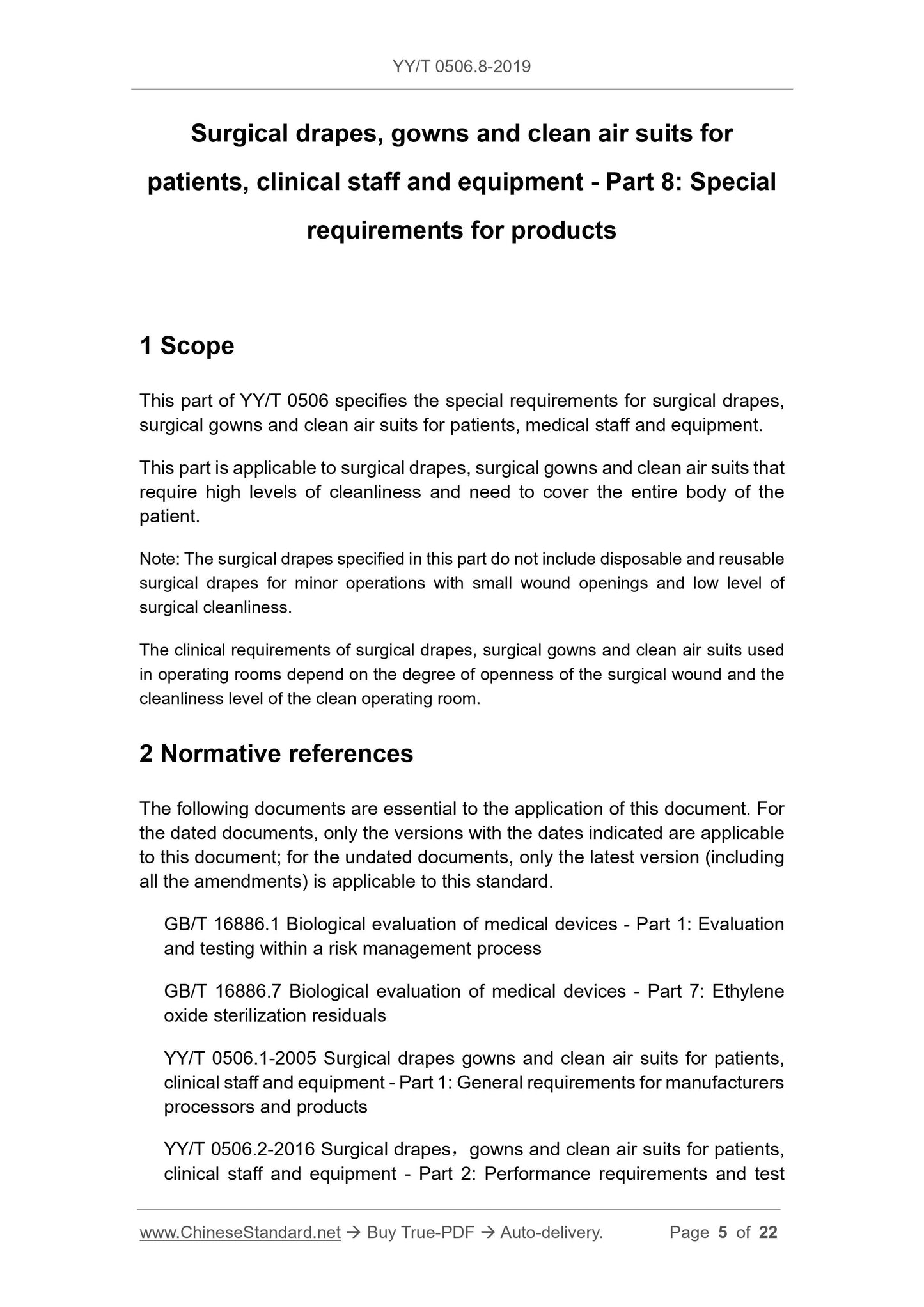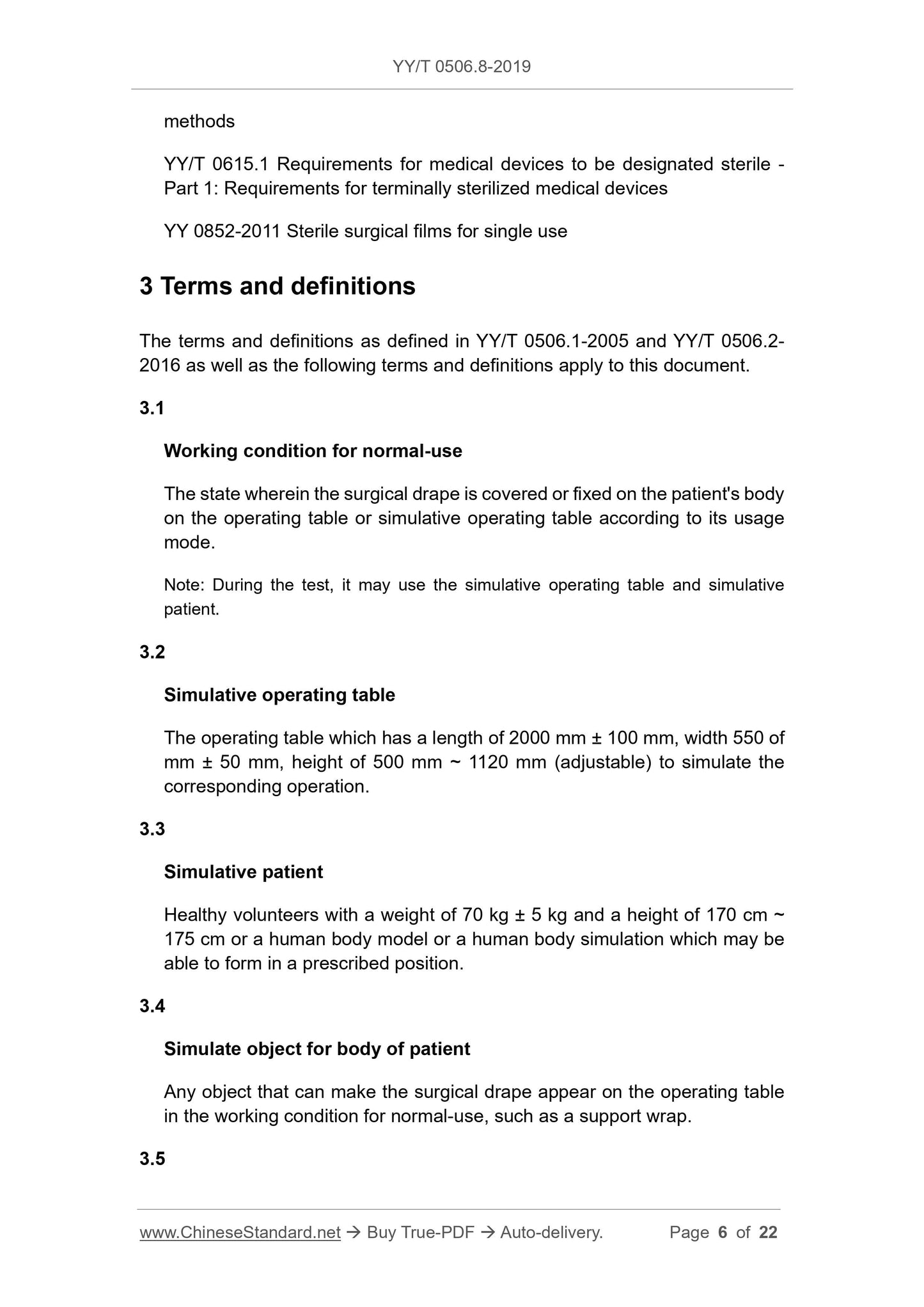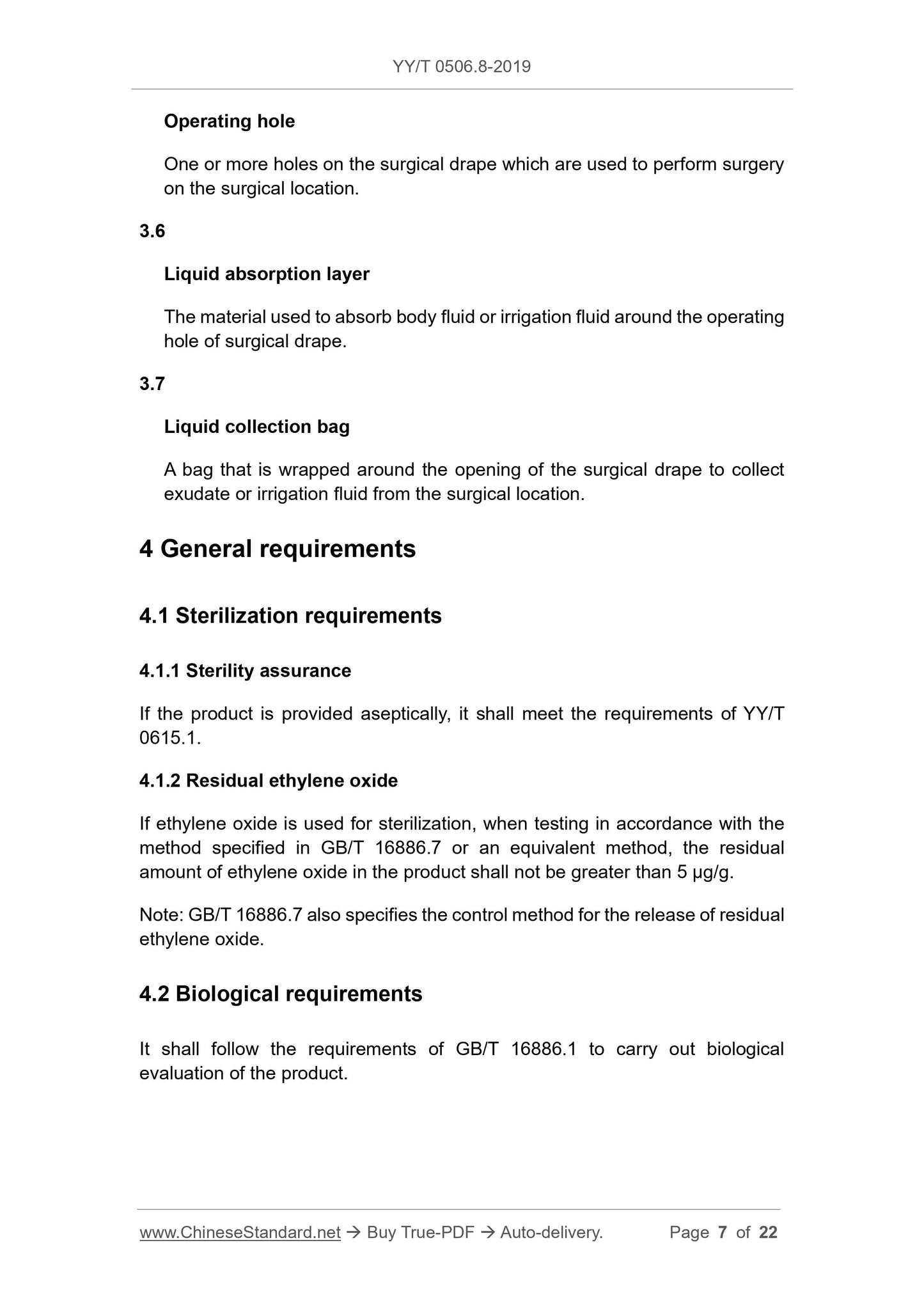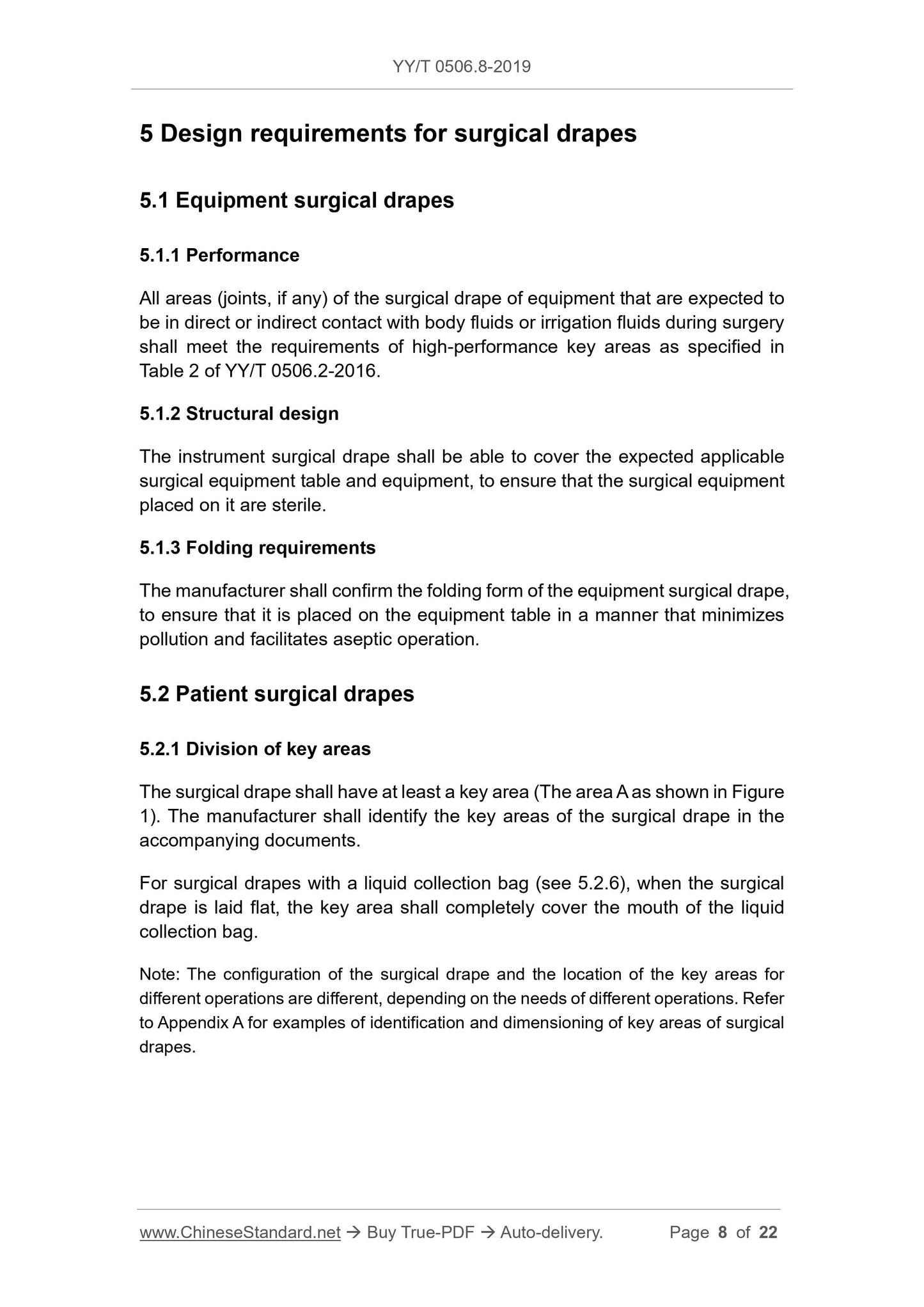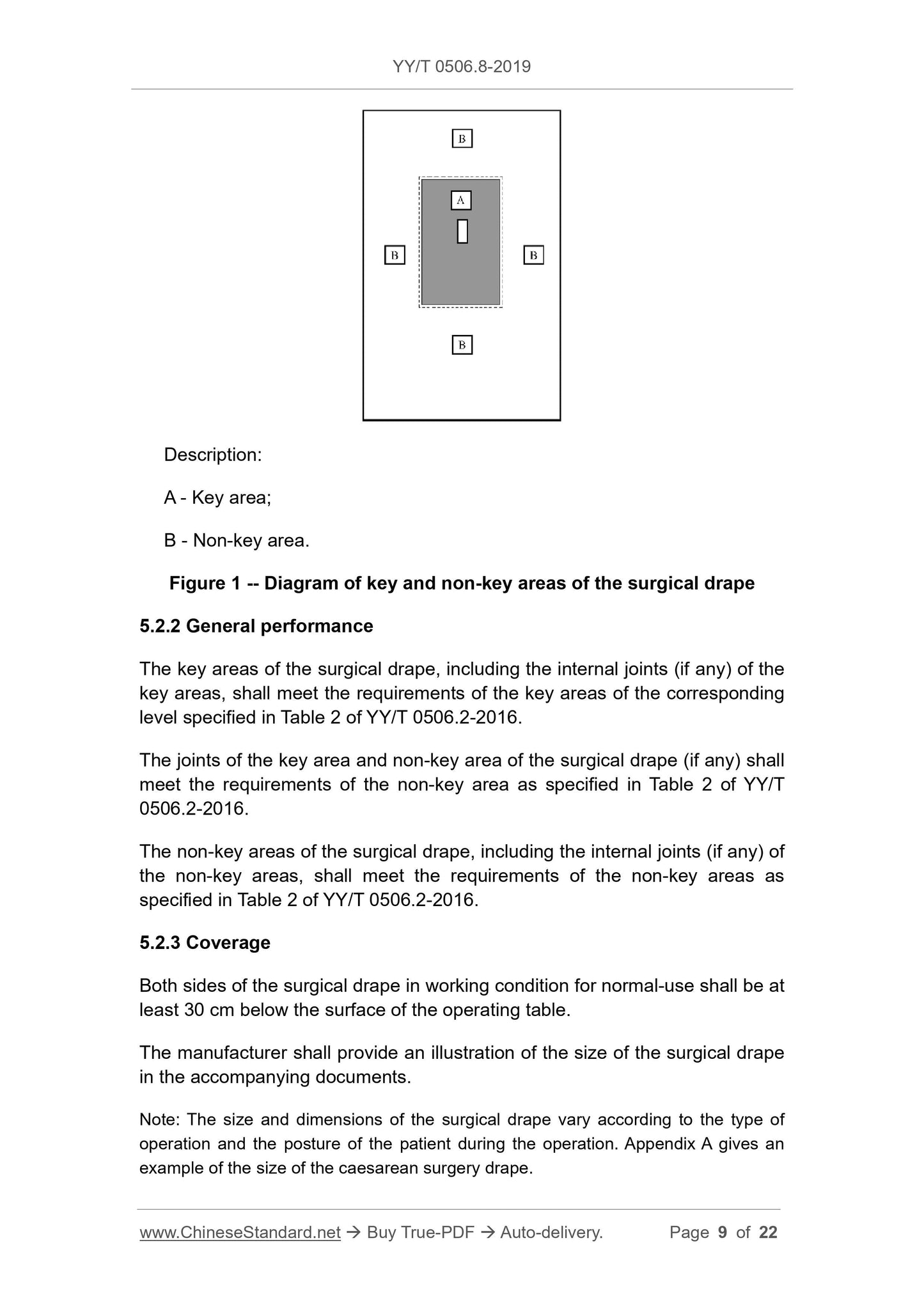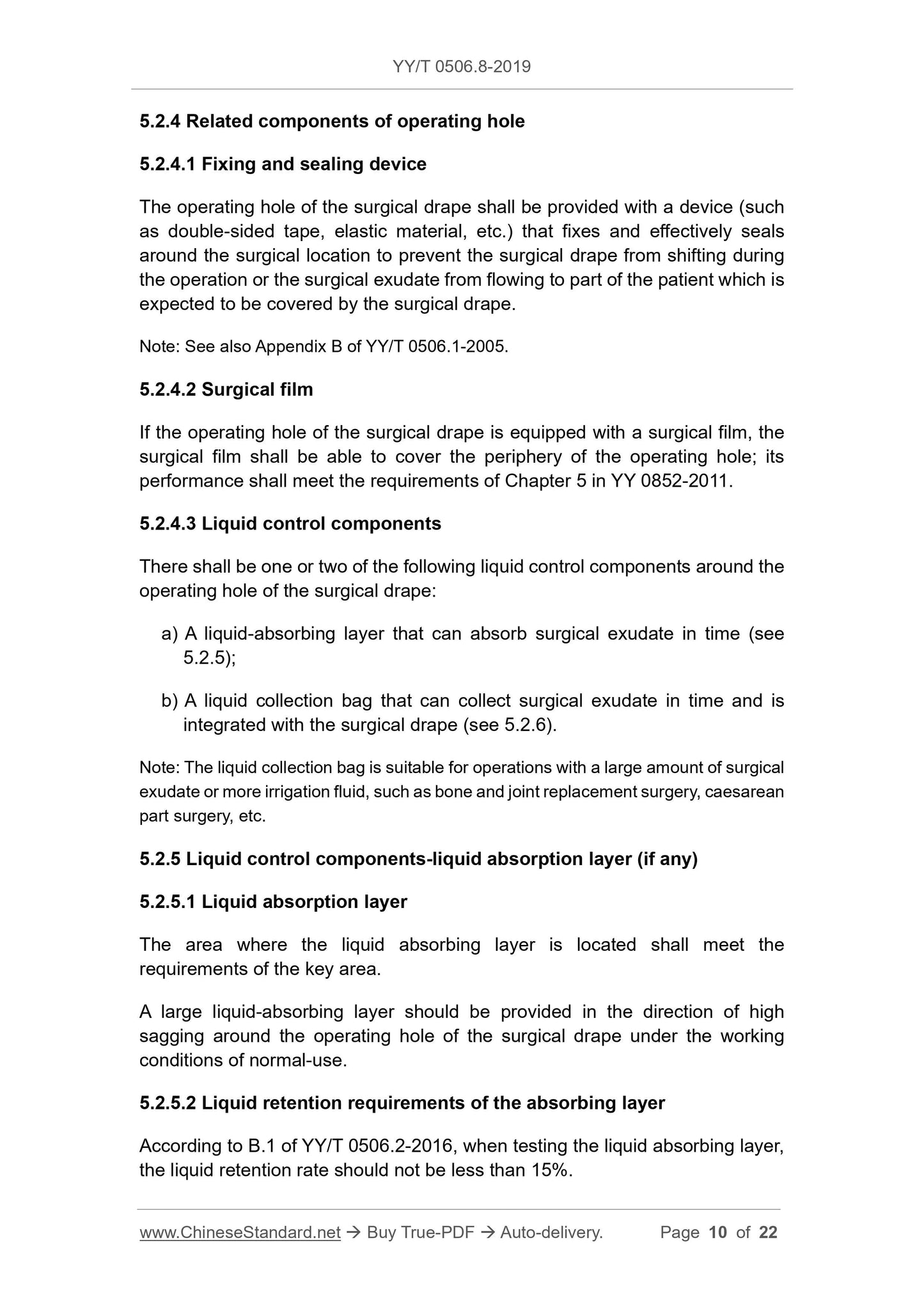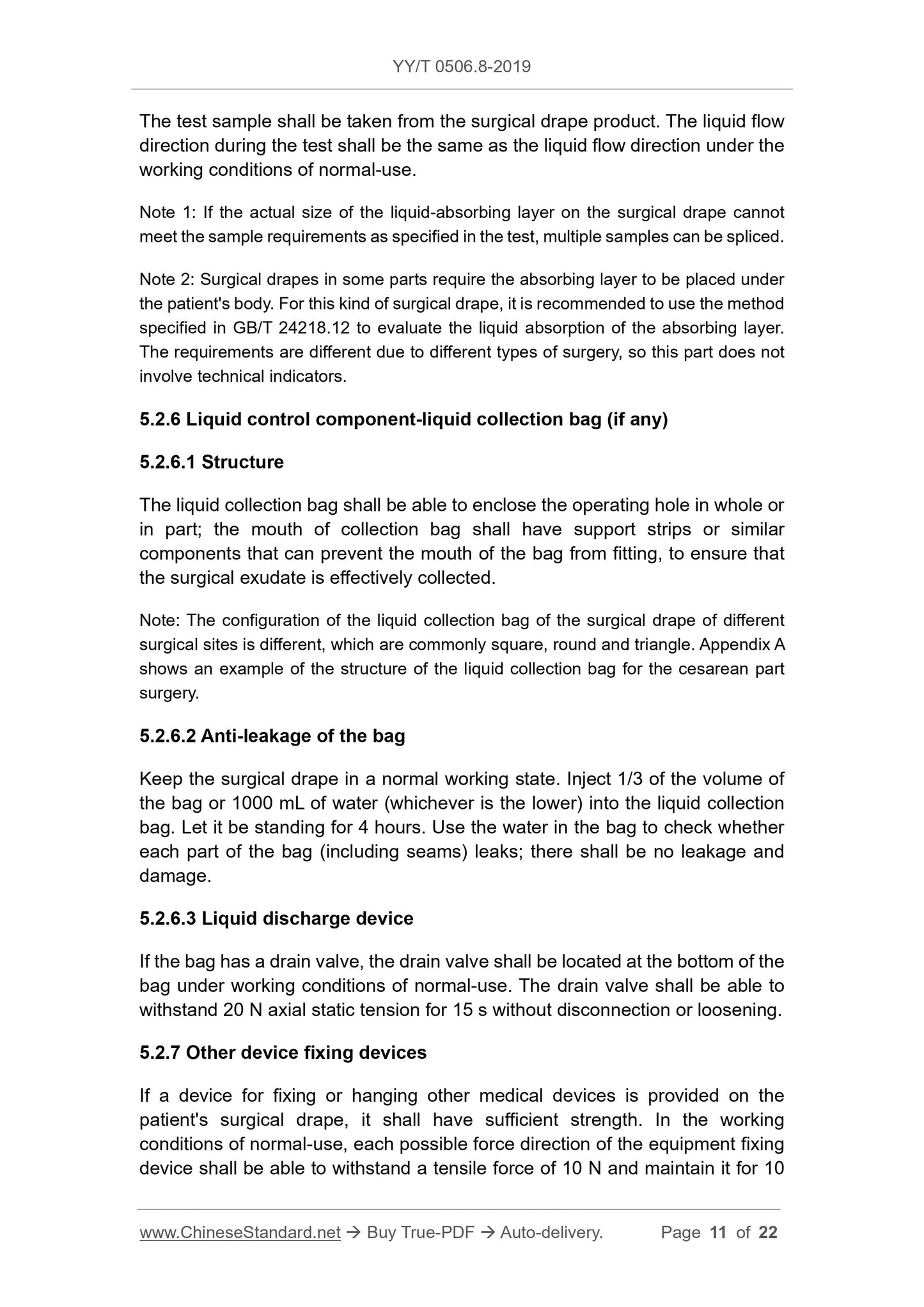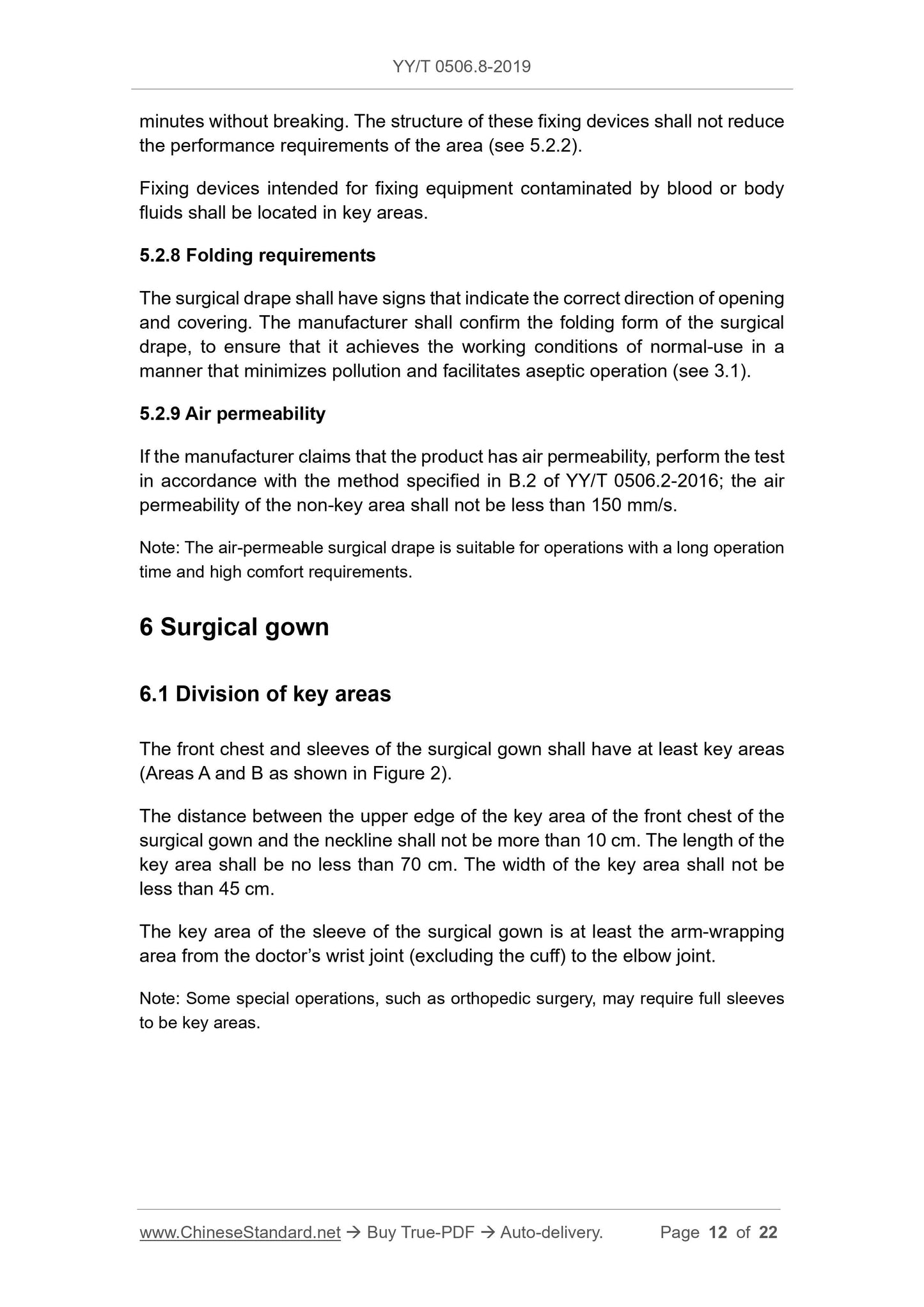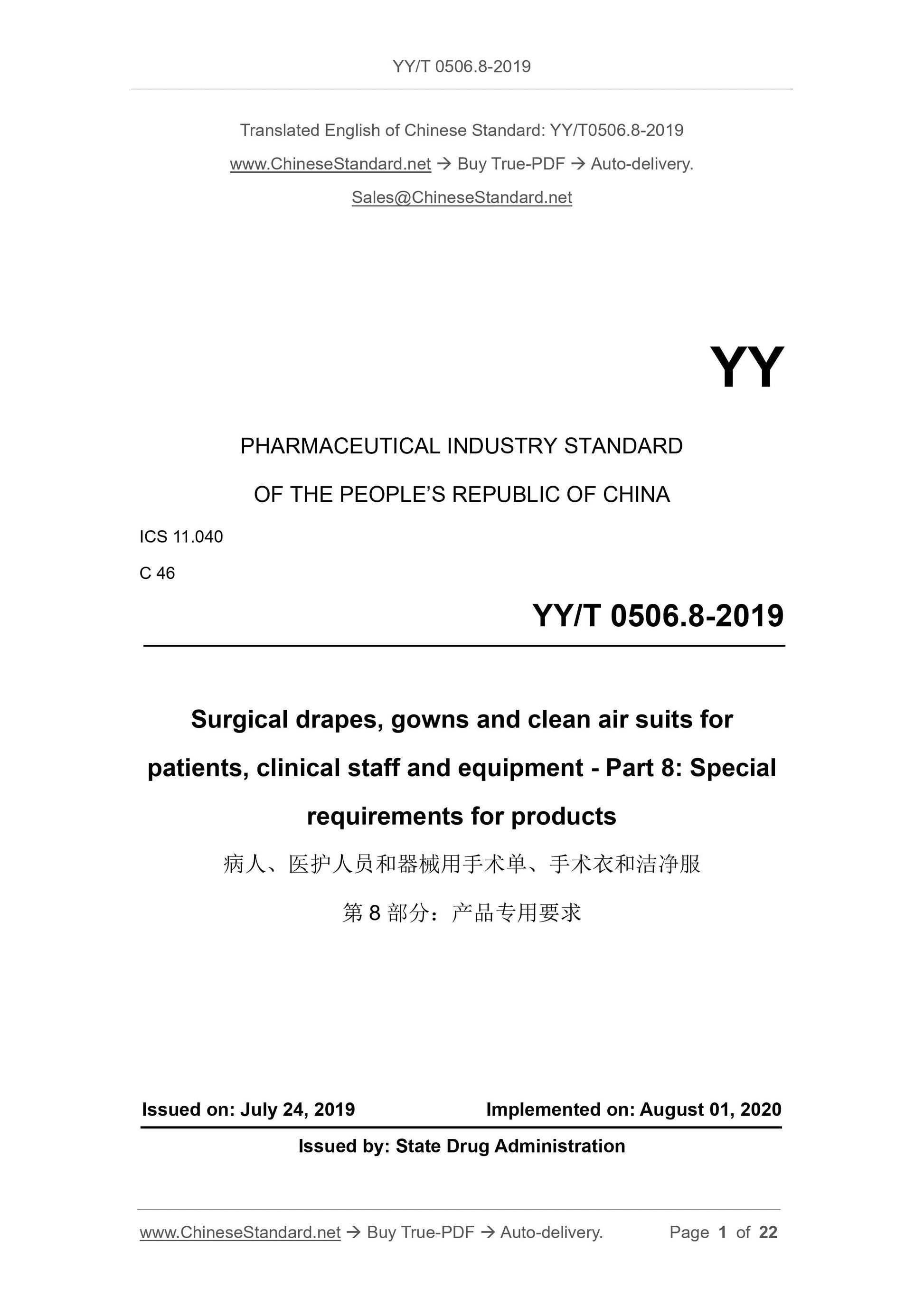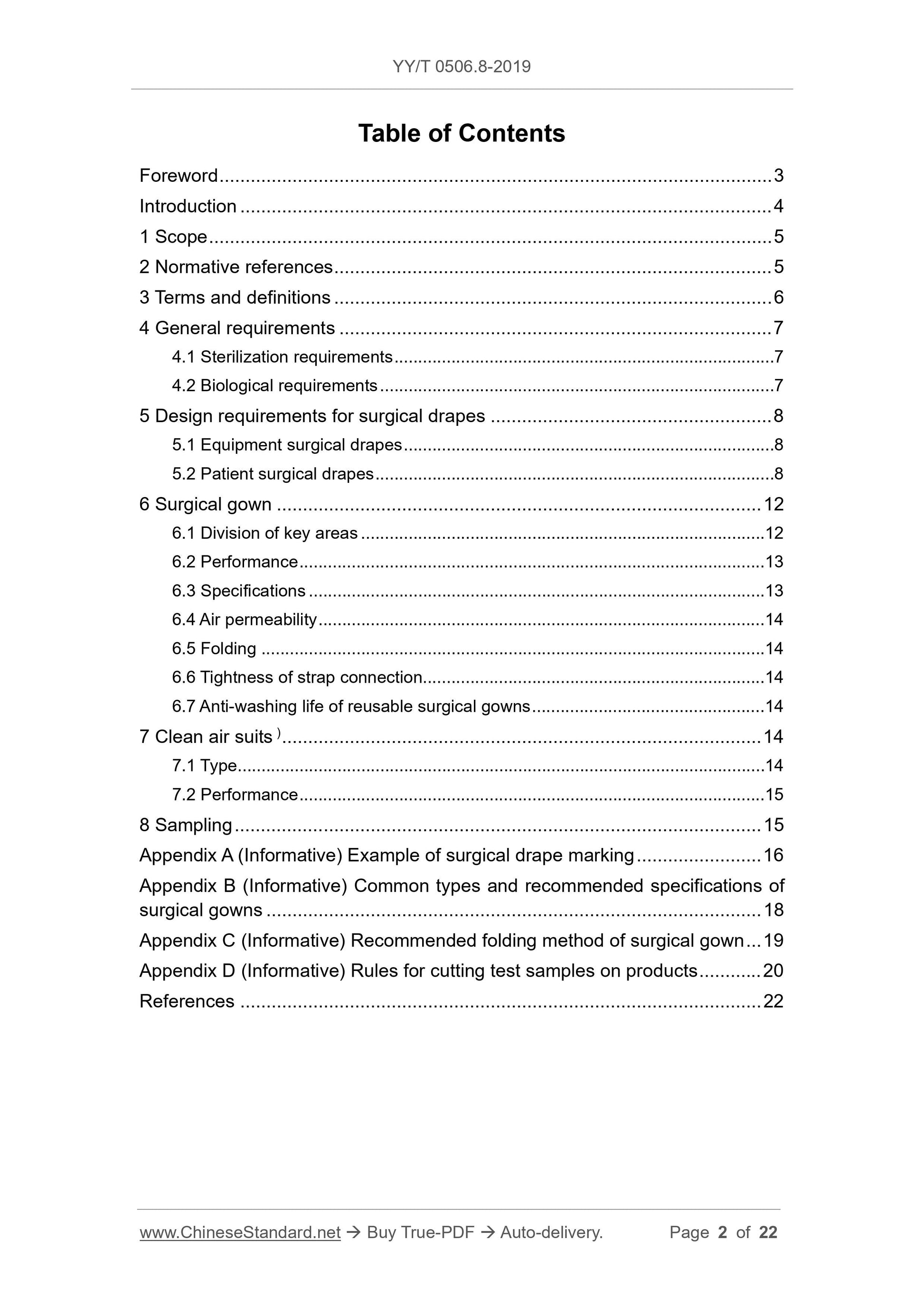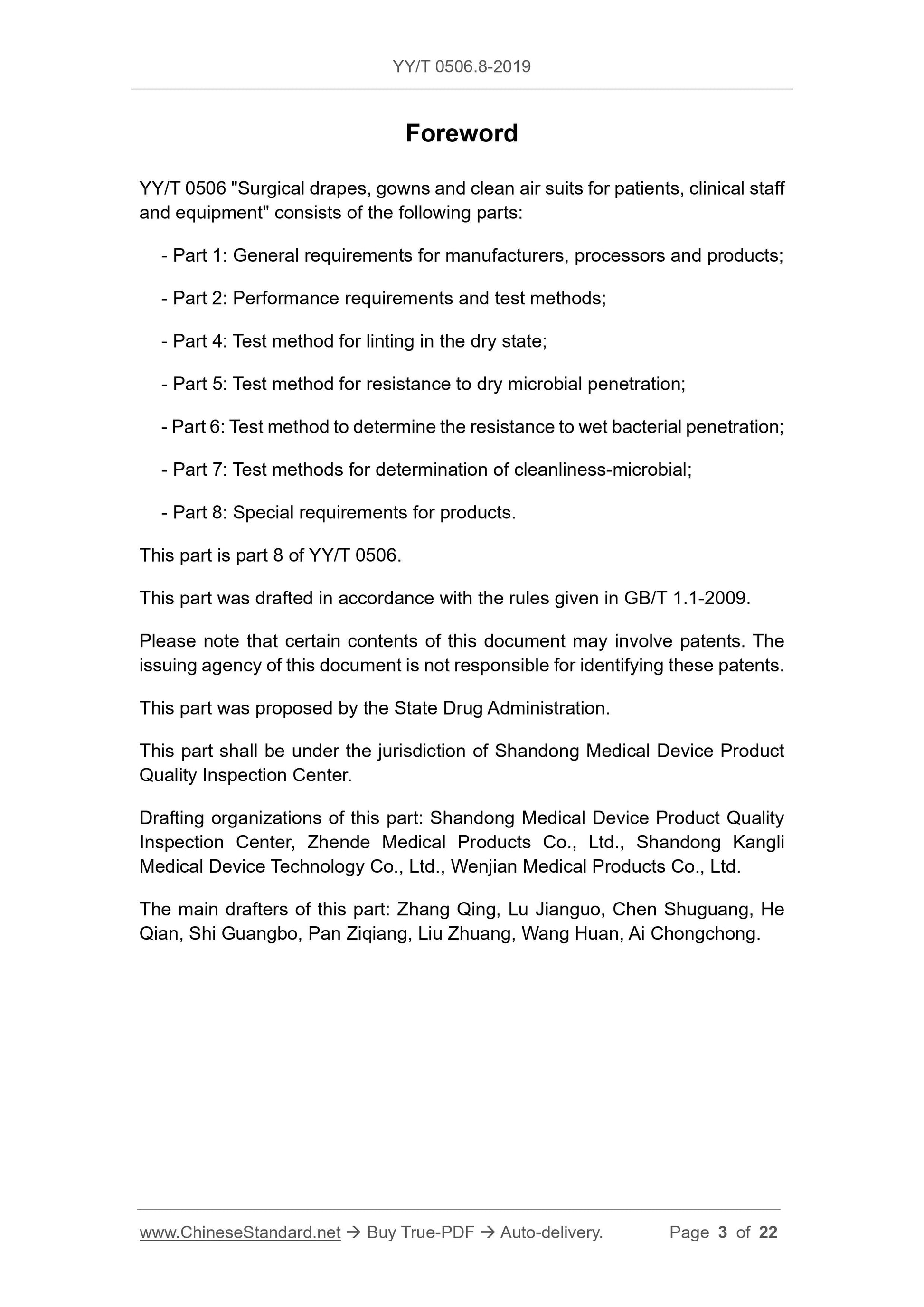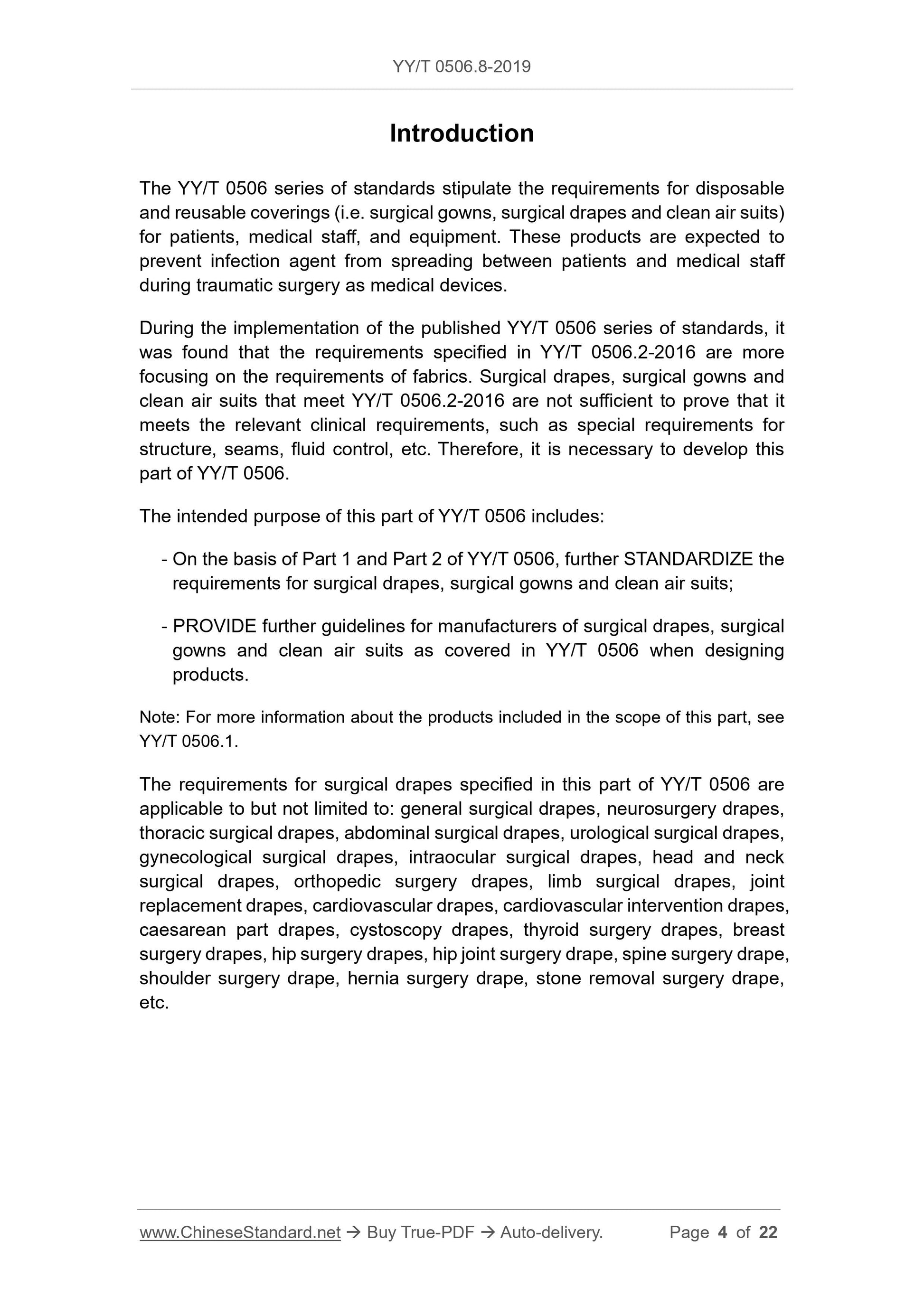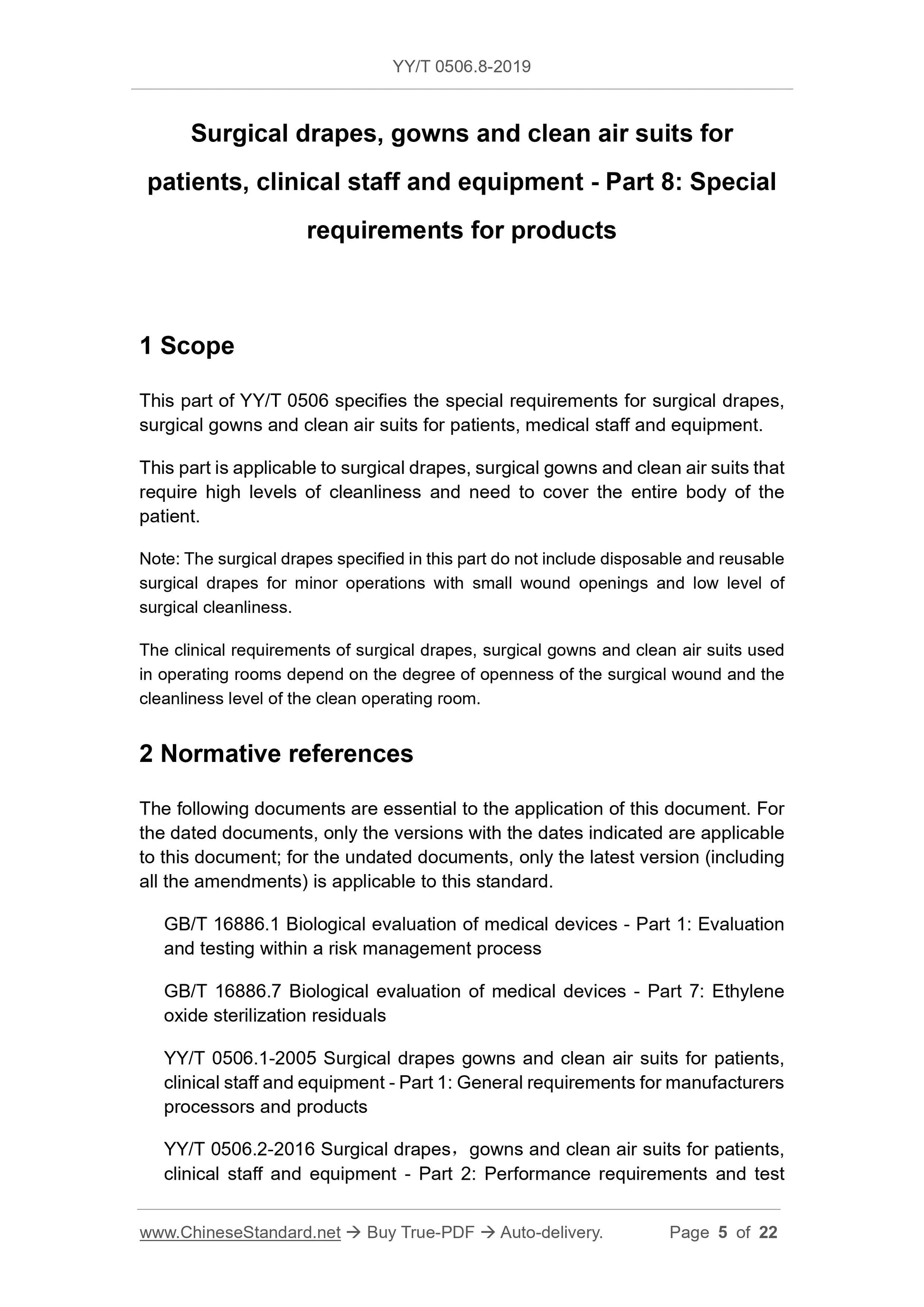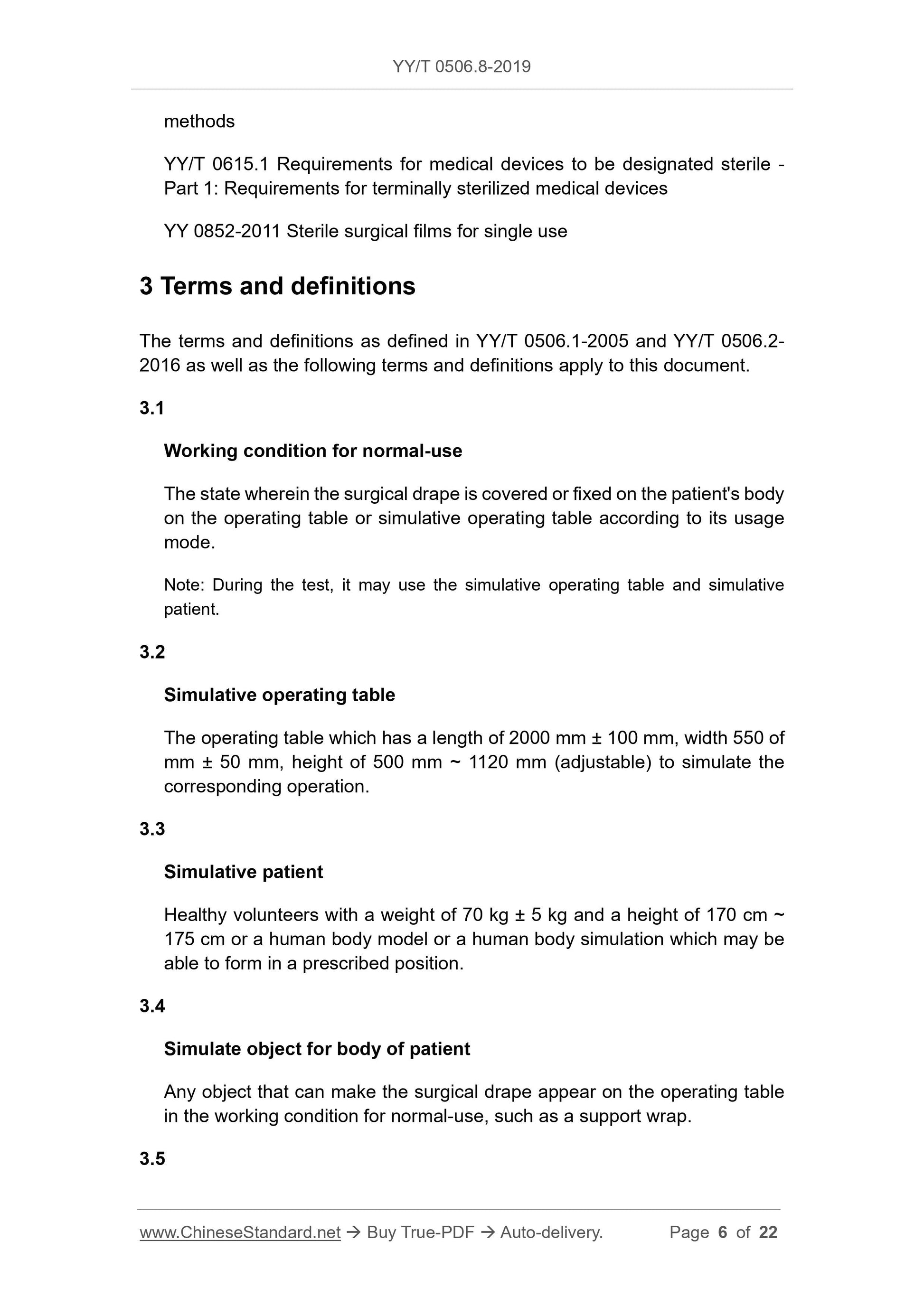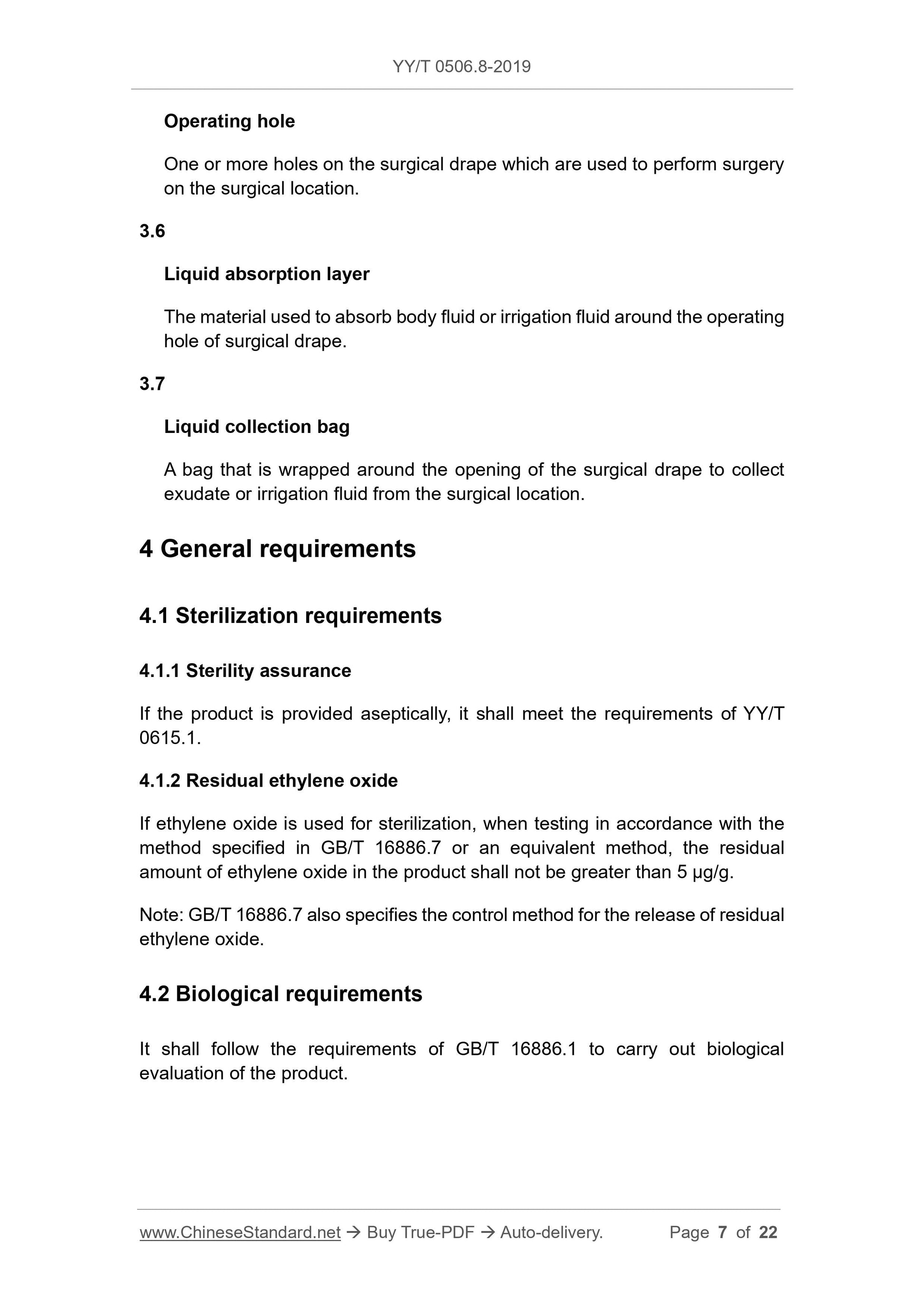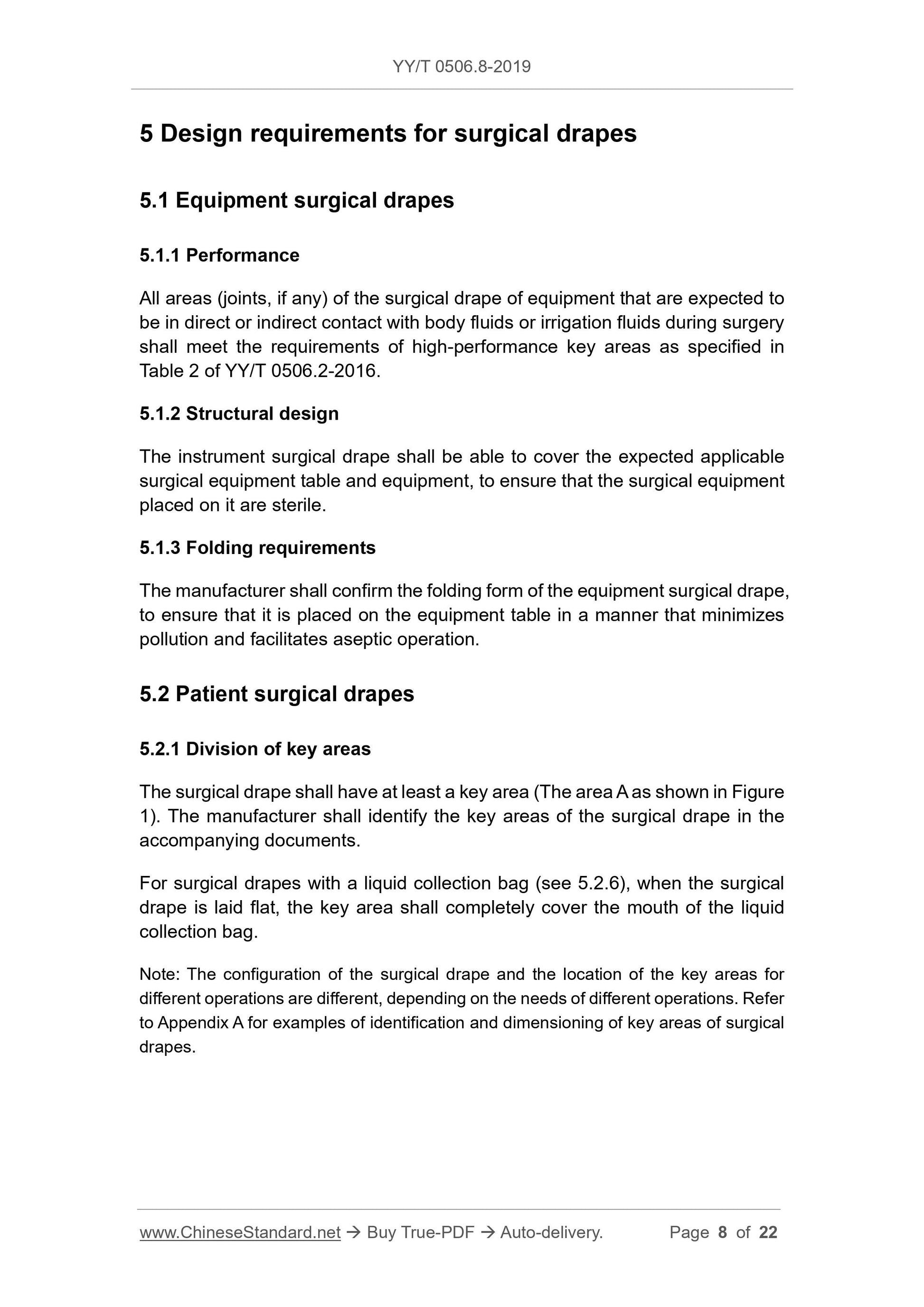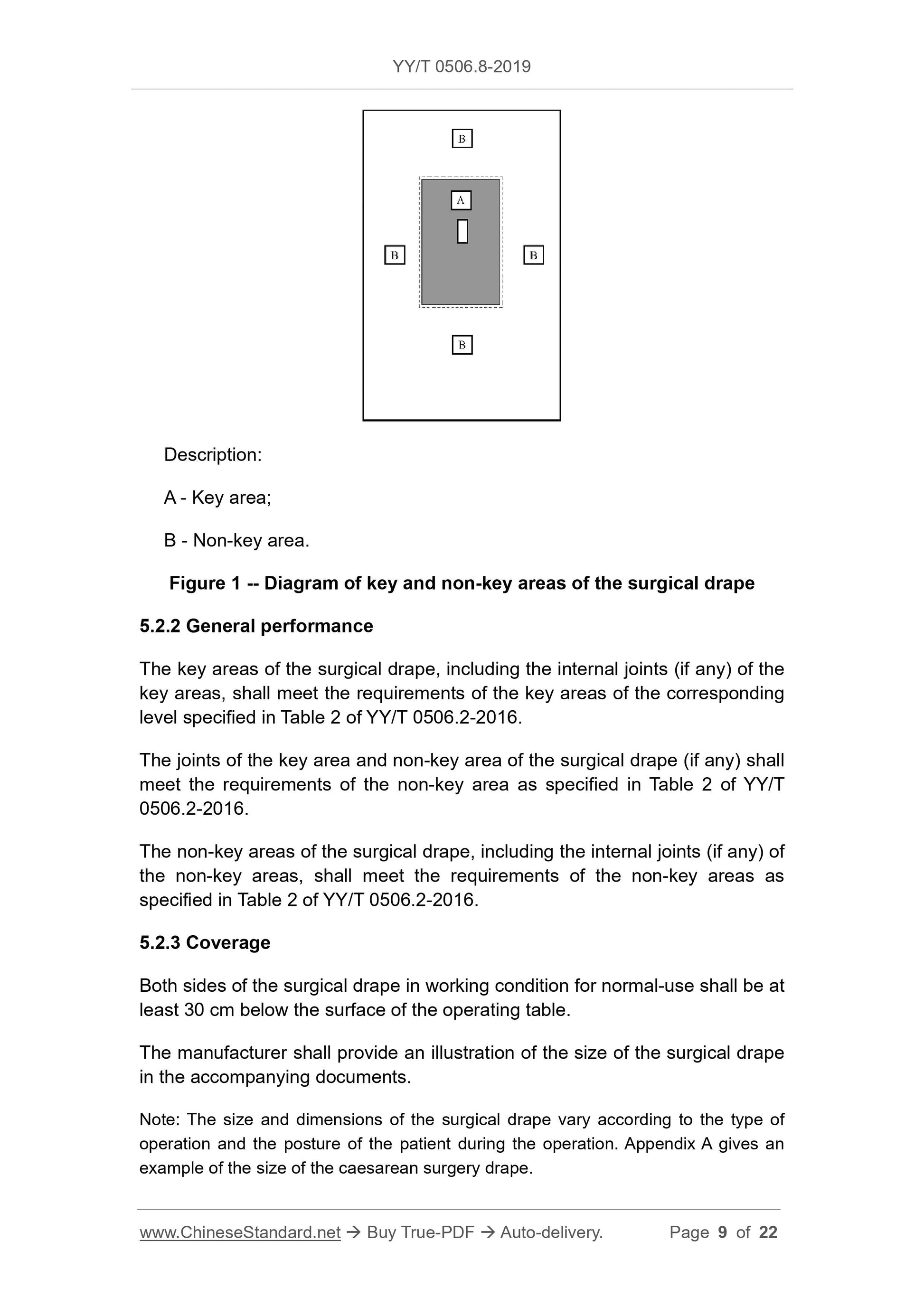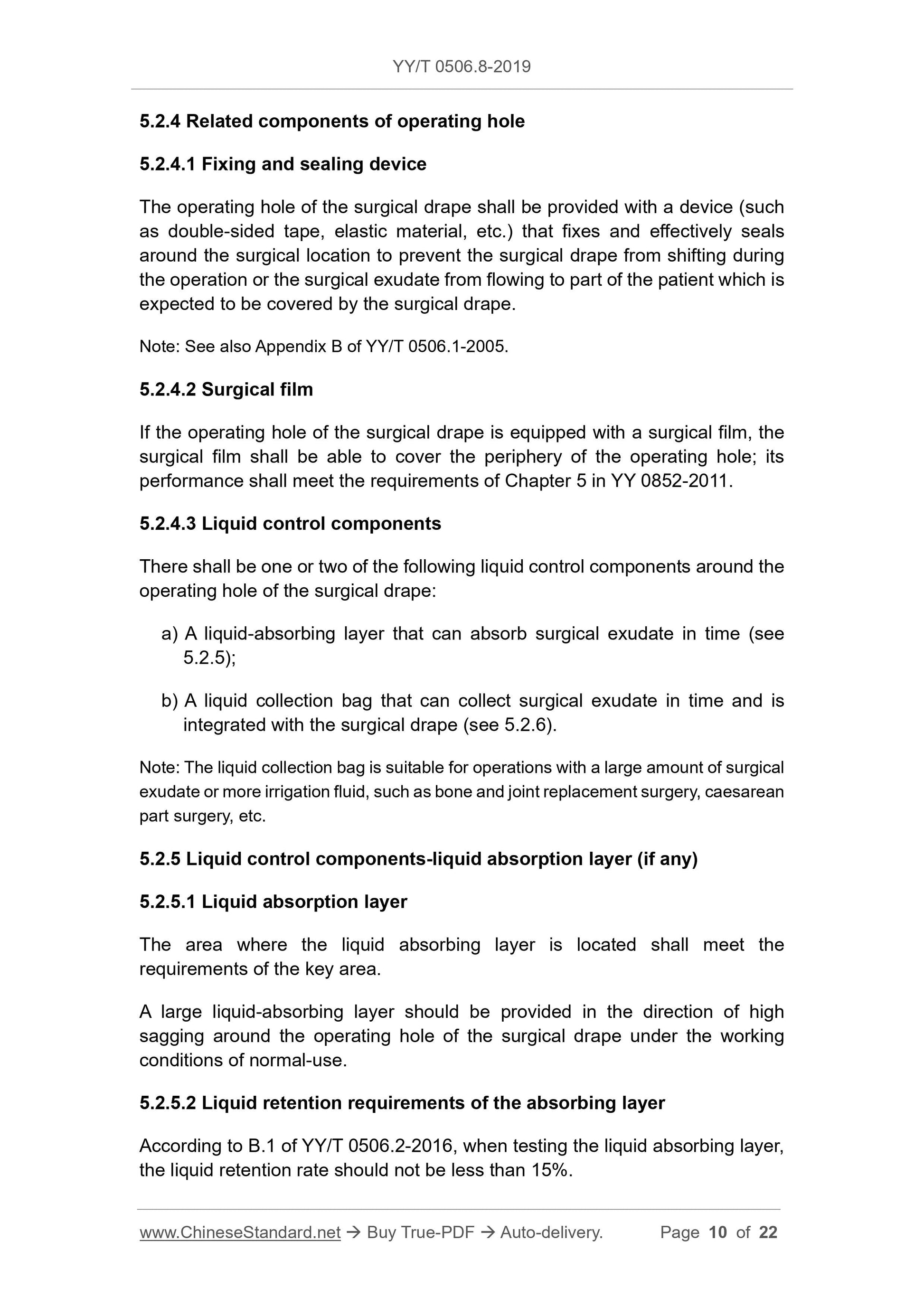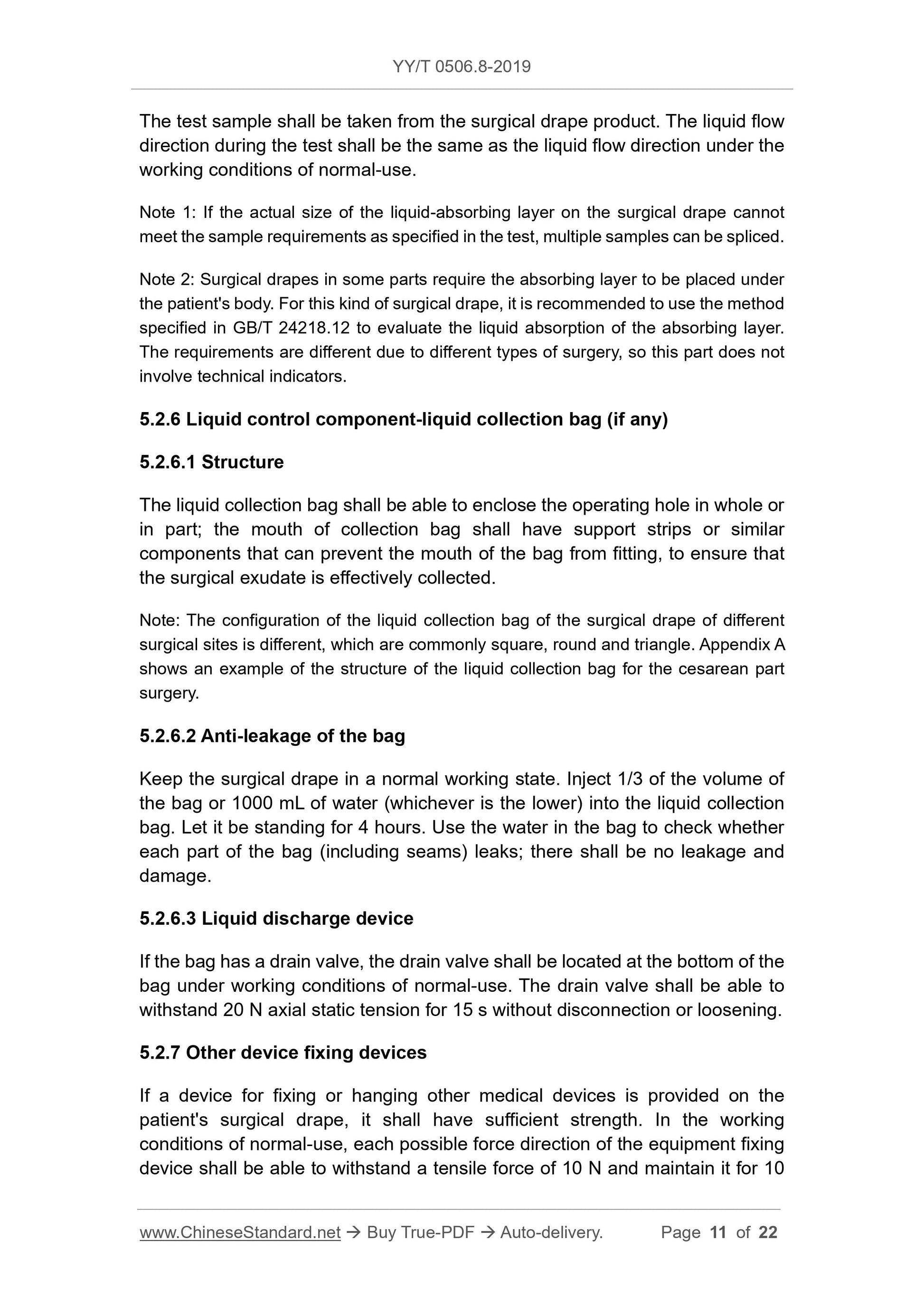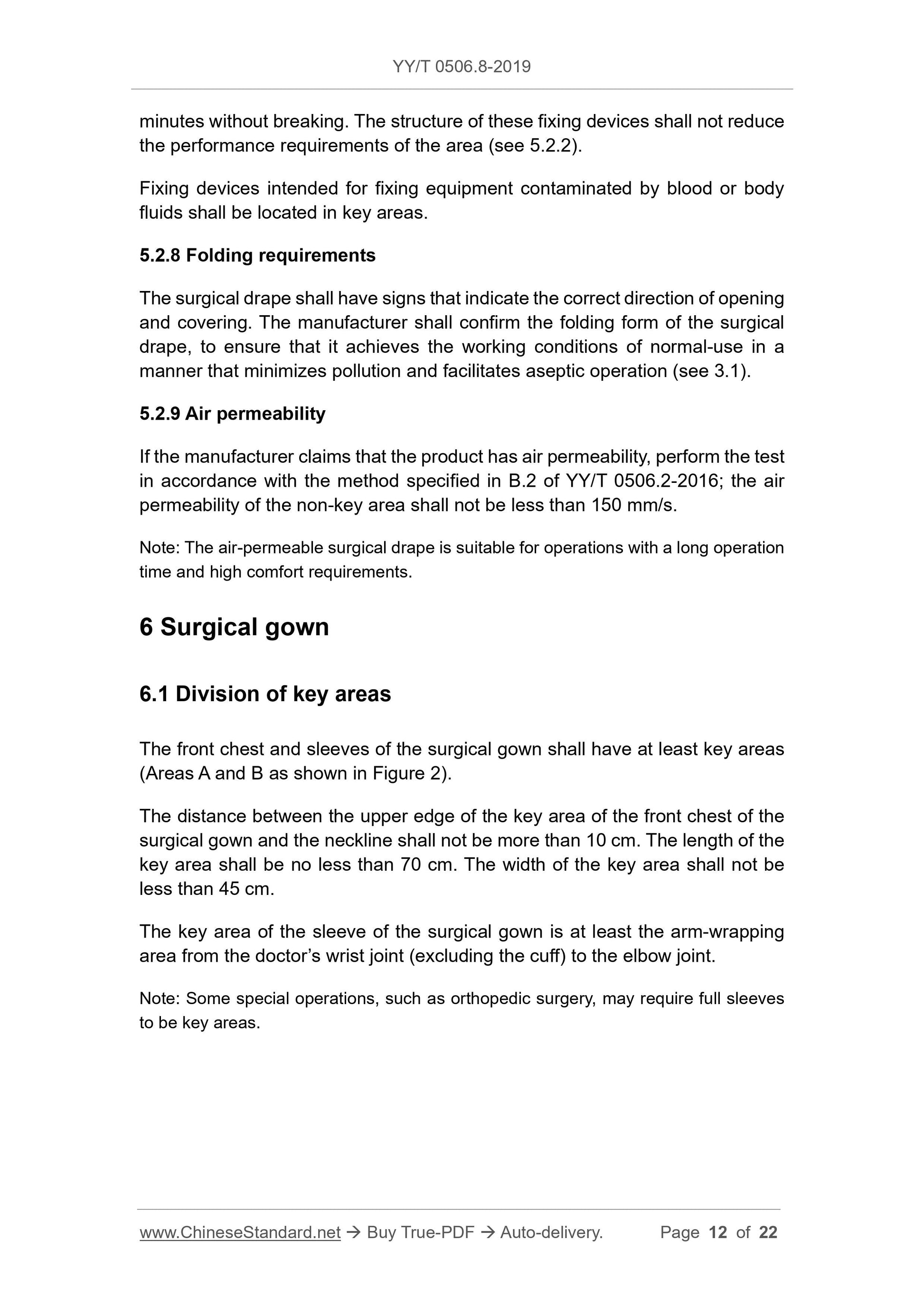1
/
von
12
PayPal, credit cards. Download editable-PDF & invoice in 1 second!
YY/T 0506.8-2019 English PDF (YYT0506.8-2019)
YY/T 0506.8-2019 English PDF (YYT0506.8-2019)
Normaler Preis
$290.00 USD
Normaler Preis
Verkaufspreis
$290.00 USD
Grundpreis
/
pro
Versand wird beim Checkout berechnet
Verfügbarkeit für Abholungen konnte nicht geladen werden
Delivery: 3 seconds. Download true-PDF + Invoice.
Get QUOTATION in 1-minute: Click YY/T 0506.8-2019
Historical versions: YY/T 0506.8-2019
Preview True-PDF (Reload/Scroll if blank)
YY/T 0506.8-2019: Surgical drapes, gowns and clean air suits for patients, clinical staff and equipment - Part 8: Special requirements for products
YY/T 0506.8-2019
YY
PHARMACEUTICAL INDUSTRY STANDARD
OF THE PEOPLE’S REPUBLIC OF CHINA
ICS 11.040
C 46
Surgical drapes, gowns and clean air suits for
patients, clinical staff and equipment - Part 8: Special
requirements for products
ISSUED ON: JULY 24, 2019
IMPLEMENTED ON: AUGUST 01, 2020
Issued by: State Drug Administration
Table of Contents
Foreword ... 3
Introduction ... 4
1 Scope ... 5
2 Normative references ... 5
3 Terms and definitions ... 6
4 General requirements ... 7
4.1 Sterilization requirements ... 7
4.2 Biological requirements ... 7
5 Design requirements for surgical drapes ... 8
5.1 Equipment surgical drapes ... 8
5.2 Patient surgical drapes ... 8
6 Surgical gown ... 12
6.1 Division of key areas ... 12
6.2 Performance ... 13
6.3 Specifications ... 13
6.4 Air permeability ... 14
6.5 Folding ... 14
6.6 Tightness of strap connection... 14
6.7 Anti-washing life of reusable surgical gowns ... 14
7 Clean air suits ) ... 14
7.1 Type ... 14
7.2 Performance ... 15
8 Sampling ... 15
Appendix A (Informative) Example of surgical drape marking ... 16
Appendix B (Informative) Common types and recommended specifications of
surgical gowns ... 18
Appendix C (Informative) Recommended folding method of surgical gown ... 19
Appendix D (Informative) Rules for cutting test samples on products ... 20
References ... 22
Surgical drapes, gowns and clean air suits for
patients, clinical staff and equipment - Part 8: Special
requirements for products
1 Scope
This part of YY/T 0506 specifies the special requirements for surgical drapes,
surgical gowns and clean air suits for patients, medical staff and equipment.
This part is applicable to surgical drapes, surgical gowns and clean air suits that
require high levels of cleanliness and need to cover the entire body of the
patient.
Note: The surgical drapes specified in this part do not include disposable and reusable
surgical drapes for minor operations with small wound openings and low level of
surgical cleanliness.
The clinical requirements of surgical drapes, surgical gowns and clean air suits used
in operating rooms depend on the degree of openness of the surgical wound and the
cleanliness level of the clean operating room.
2 Normative references
The following documents are essential to the application of this document. For
the dated documents, only the versions with the dates indicated are applicable
to this document; for the undated documents, only the latest version (including
all the amendments) is applicable to this standard.
GB/T 16886.1 Biological evaluation of medical devices - Part 1: Evaluation
and testing within a risk management process
GB/T 16886.7 Biological evaluation of medical devices - Part 7: Ethylene
oxide sterilization residuals
YY/T 0506.1-2005 Surgical drapes gowns and clean air suits for patients,
clinical staff and equipment - Part 1: General requirements for manufacturers
processors and products
YY/T 0506.2-2016 Surgical drapes, gowns and clean air suits for patients,
clinical staff and equipment - Part 2: Performance requirements and test
Operating hole
One or more holes on the surgical drape which are used to perform surgery
on the surgical location.
3.6
Liquid absorption layer
The material used to absorb body fluid or irrigation fluid around the operating
hole of surgical drape.
3.7
Liquid collection bag
A bag that is wrapped around the opening of the surgical drape to collect
exudate or irrigation fluid from the surgical location.
4 General requirements
4.1 Sterilization requirements
4.1.1 Sterility assurance
If the product is provided aseptically, it shall meet the requirements of YY/T
0615.1.
4.1.2 Residual ethylene oxide
If ethylene oxide is used for sterilization, when testing in accordance with the
method specified in GB/T 16886.7 or an equivalent method, the residual
amount of ethylene oxide in the product shall not be greater than 5 μg/g.
Note: GB/T 16886.7 also specifies the control method for the release of residual
ethylene oxide.
4.2 Biological requirements
It shall follow the requirements of GB/T 16886.1 to carry out biological
evaluation of the product.
5.2.4 Related components of operating hole
5.2.4.1 Fixing and sealing device
The operating hole of the surgical drape shall be provided with a device (such
as double-sided tape, elastic material, etc.) that fixes and effectively seals
around the surgical location to prevent the surgical drape from shifting during
the operation or the surgical exudate from flowing to part of the patient which is
expected to be covered by the surgical drape.
Note: See also Appendix B of YY/T 0506.1-2005.
5.2.4.2 Surgical film
If the operating hole of the surgical drape is equipped with a surgical film, the
surgical film shall be able to cover the periphery of the operating hole; its
performance shall meet the requirements of Chapter 5 in YY 0852-2011.
5.2.4.3 Liquid control components
There shall be one or two of the following liquid control components around the
operating hole of the surgical drape:
a) A liquid-absorbing layer that can absorb surgical exudate in time (see
5.2.5);
b) A liquid collection bag that can collect surgical exudate in time and is
integrated with the surgical drape (see 5.2.6).
Note: The liquid collection bag is suitable for operations with a large amount of surgical
exudate or more irrigation fluid, such as bone and joint replacement surgery, caesarean
part surgery, etc.
5.2.5 Liquid control components-liquid absorption layer (if any)
5.2.5.1 Liquid absorption layer
The area where the liquid absorbing layer is located shall meet the
requirements of the key area.
A large liquid-absorbing layer should be provided in the direction of high
sagging around the operating hole of the surgical drape under the working
conditions of normal-use.
5.2.5.2 Liquid retention requirements of the absorbing layer
According to B.1 of YY/T 0506.2-2016, when testing the liquid absorbing layer,
the liquid retention rate should not be less than 15%.
minutes without breaking. The structure of these fixing devices shall not reduce
the performance requirements of the area (see 5.2.2).
Fixing devices intended for fixing equipment contaminated by blood or body
fluids shall be located in key areas.
5.2.8 Folding requirements
The surgical drape shall have signs that indicate the correct direction of opening
and covering. The manufacturer shall confirm the folding form of the surgical
drape, to ensure that it achieves the working conditions of normal-use in a
manner that minimizes pollution and facilitates aseptic operation (see 3.1).
5.2.9 Air permeability
If the manufacturer claims that the product has air permeability, perform the test
in accordance with the method specified in B.2 of YY/T 0506.2-2016; the air
permeability of the non-key area shall not be less than 150 mm/s.
Note: The air-permeable surgical drape is suitable for operations with a long operation
time and high comfort requirements.
6 Surgical gown
6.1 Division of key areas
The front chest and sleeves of the surgical gown shall have at least key areas
(Areas A and B as shown in Figure 2).
The distance between the upper edge of the key area of the front chest of the
surgical gown and the neckline shall not be more than 10 cm. ...
Get QUOTATION in 1-minute: Click YY/T 0506.8-2019
Historical versions: YY/T 0506.8-2019
Preview True-PDF (Reload/Scroll if blank)
YY/T 0506.8-2019: Surgical drapes, gowns and clean air suits for patients, clinical staff and equipment - Part 8: Special requirements for products
YY/T 0506.8-2019
YY
PHARMACEUTICAL INDUSTRY STANDARD
OF THE PEOPLE’S REPUBLIC OF CHINA
ICS 11.040
C 46
Surgical drapes, gowns and clean air suits for
patients, clinical staff and equipment - Part 8: Special
requirements for products
ISSUED ON: JULY 24, 2019
IMPLEMENTED ON: AUGUST 01, 2020
Issued by: State Drug Administration
Table of Contents
Foreword ... 3
Introduction ... 4
1 Scope ... 5
2 Normative references ... 5
3 Terms and definitions ... 6
4 General requirements ... 7
4.1 Sterilization requirements ... 7
4.2 Biological requirements ... 7
5 Design requirements for surgical drapes ... 8
5.1 Equipment surgical drapes ... 8
5.2 Patient surgical drapes ... 8
6 Surgical gown ... 12
6.1 Division of key areas ... 12
6.2 Performance ... 13
6.3 Specifications ... 13
6.4 Air permeability ... 14
6.5 Folding ... 14
6.6 Tightness of strap connection... 14
6.7 Anti-washing life of reusable surgical gowns ... 14
7 Clean air suits ) ... 14
7.1 Type ... 14
7.2 Performance ... 15
8 Sampling ... 15
Appendix A (Informative) Example of surgical drape marking ... 16
Appendix B (Informative) Common types and recommended specifications of
surgical gowns ... 18
Appendix C (Informative) Recommended folding method of surgical gown ... 19
Appendix D (Informative) Rules for cutting test samples on products ... 20
References ... 22
Surgical drapes, gowns and clean air suits for
patients, clinical staff and equipment - Part 8: Special
requirements for products
1 Scope
This part of YY/T 0506 specifies the special requirements for surgical drapes,
surgical gowns and clean air suits for patients, medical staff and equipment.
This part is applicable to surgical drapes, surgical gowns and clean air suits that
require high levels of cleanliness and need to cover the entire body of the
patient.
Note: The surgical drapes specified in this part do not include disposable and reusable
surgical drapes for minor operations with small wound openings and low level of
surgical cleanliness.
The clinical requirements of surgical drapes, surgical gowns and clean air suits used
in operating rooms depend on the degree of openness of the surgical wound and the
cleanliness level of the clean operating room.
2 Normative references
The following documents are essential to the application of this document. For
the dated documents, only the versions with the dates indicated are applicable
to this document; for the undated documents, only the latest version (including
all the amendments) is applicable to this standard.
GB/T 16886.1 Biological evaluation of medical devices - Part 1: Evaluation
and testing within a risk management process
GB/T 16886.7 Biological evaluation of medical devices - Part 7: Ethylene
oxide sterilization residuals
YY/T 0506.1-2005 Surgical drapes gowns and clean air suits for patients,
clinical staff and equipment - Part 1: General requirements for manufacturers
processors and products
YY/T 0506.2-2016 Surgical drapes, gowns and clean air suits for patients,
clinical staff and equipment - Part 2: Performance requirements and test
Operating hole
One or more holes on the surgical drape which are used to perform surgery
on the surgical location.
3.6
Liquid absorption layer
The material used to absorb body fluid or irrigation fluid around the operating
hole of surgical drape.
3.7
Liquid collection bag
A bag that is wrapped around the opening of the surgical drape to collect
exudate or irrigation fluid from the surgical location.
4 General requirements
4.1 Sterilization requirements
4.1.1 Sterility assurance
If the product is provided aseptically, it shall meet the requirements of YY/T
0615.1.
4.1.2 Residual ethylene oxide
If ethylene oxide is used for sterilization, when testing in accordance with the
method specified in GB/T 16886.7 or an equivalent method, the residual
amount of ethylene oxide in the product shall not be greater than 5 μg/g.
Note: GB/T 16886.7 also specifies the control method for the release of residual
ethylene oxide.
4.2 Biological requirements
It shall follow the requirements of GB/T 16886.1 to carry out biological
evaluation of the product.
5.2.4 Related components of operating hole
5.2.4.1 Fixing and sealing device
The operating hole of the surgical drape shall be provided with a device (such
as double-sided tape, elastic material, etc.) that fixes and effectively seals
around the surgical location to prevent the surgical drape from shifting during
the operation or the surgical exudate from flowing to part of the patient which is
expected to be covered by the surgical drape.
Note: See also Appendix B of YY/T 0506.1-2005.
5.2.4.2 Surgical film
If the operating hole of the surgical drape is equipped with a surgical film, the
surgical film shall be able to cover the periphery of the operating hole; its
performance shall meet the requirements of Chapter 5 in YY 0852-2011.
5.2.4.3 Liquid control components
There shall be one or two of the following liquid control components around the
operating hole of the surgical drape:
a) A liquid-absorbing layer that can absorb surgical exudate in time (see
5.2.5);
b) A liquid collection bag that can collect surgical exudate in time and is
integrated with the surgical drape (see 5.2.6).
Note: The liquid collection bag is suitable for operations with a large amount of surgical
exudate or more irrigation fluid, such as bone and joint replacement surgery, caesarean
part surgery, etc.
5.2.5 Liquid control components-liquid absorption layer (if any)
5.2.5.1 Liquid absorption layer
The area where the liquid absorbing layer is located shall meet the
requirements of the key area.
A large liquid-absorbing layer should be provided in the direction of high
sagging around the operating hole of the surgical drape under the working
conditions of normal-use.
5.2.5.2 Liquid retention requirements of the absorbing layer
According to B.1 of YY/T 0506.2-2016, when testing the liquid absorbing layer,
the liquid retention rate should not be less than 15%.
minutes without breaking. The structure of these fixing devices shall not reduce
the performance requirements of the area (see 5.2.2).
Fixing devices intended for fixing equipment contaminated by blood or body
fluids shall be located in key areas.
5.2.8 Folding requirements
The surgical drape shall have signs that indicate the correct direction of opening
and covering. The manufacturer shall confirm the folding form of the surgical
drape, to ensure that it achieves the working conditions of normal-use in a
manner that minimizes pollution and facilitates aseptic operation (see 3.1).
5.2.9 Air permeability
If the manufacturer claims that the product has air permeability, perform the test
in accordance with the method specified in B.2 of YY/T 0506.2-2016; the air
permeability of the non-key area shall not be less than 150 mm/s.
Note: The air-permeable surgical drape is suitable for operations with a long operation
time and high comfort requirements.
6 Surgical gown
6.1 Division of key areas
The front chest and sleeves of the surgical gown shall have at least key areas
(Areas A and B as shown in Figure 2).
The distance between the upper edge of the key area of the front chest of the
surgical gown and the neckline shall not be more than 10 cm. ...
Share
